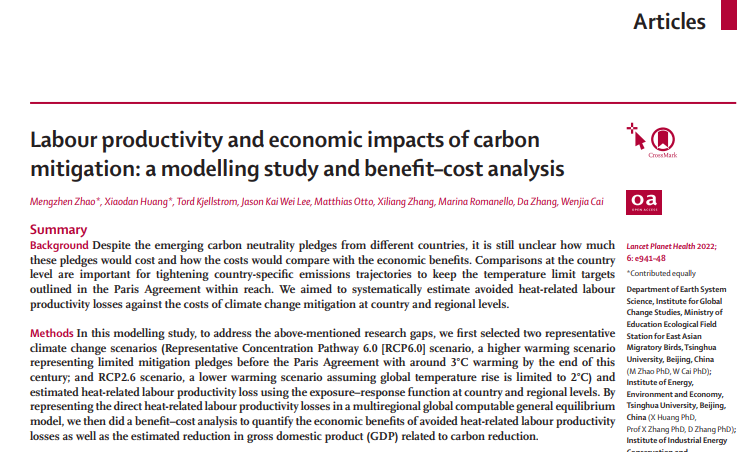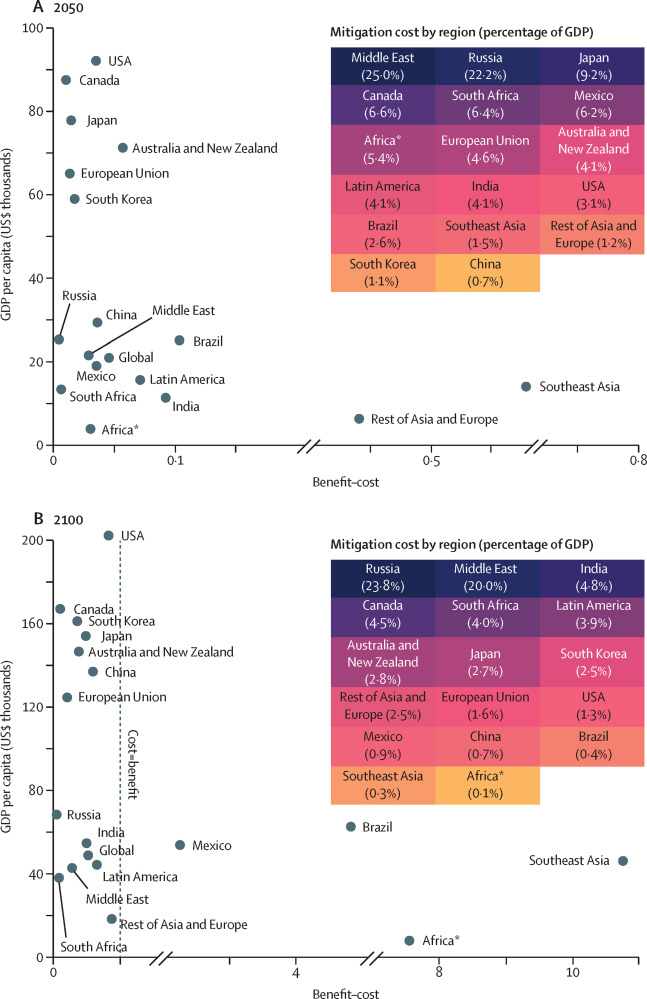Despite the emerging carbon neutrality pledges from different countries, it is still unclear how much these pledges would cost and how the costs would compare with the economic benefits. Comparisons at the country level are important for tightening country-specific emissions trajectories to keep the temperature limit targets outlined in the Paris Agreement within reach.
Then the Research Group of Associate Professor CAI Wenjia of the Department of Earth System Science (DESS), Tsinghua University and the Research Group of Professor ZHANG Xiliang and Associate Professor ZHANG Da of the Institute of Energy, Environment, and Economy(3E), Tsinghua University, carried out relevant research together with scholars from many countries.They aimed to systematically estimate avoided heat-related labour productivity losses against the costs of climate change mitigation at country and regional levels.
The results were published online in a paper titled Labour productivity and economic impacts of carbon mitigation: a modelling study and benefit–cost analysis in The Lancet Planetary Health on December 8th, 2022.

In this modelling study, to address the above-mentioned research gaps, we first selected two representative climate change scenarios and estimated heat-related labour productivity loss using the exposure–response function at country and regional levels. By representing the direct heat-related labour productivity losses in a multiregional global computable general equilibrium model, the researchers then did a benefit–cost analysis to quantify the economic benefits of avoided heat-related labour productivity losses as well as the estimated reduction in gross domestic product (GDP) related to carbon reduction.
They found that by 2100, the overall economic losses due to heat-related labour productivity loss could range from about 1.5% of global GDP under the RCP6.0 scenario to about 0.1% of global GDP under the RCP2.6 scenario. The productivity losses will be highly concentrated in low-latitude regions, especially in southeast Asia, India, and the Middle East, implying the necessity of additional adaptation measures. By 2100, about 51.8% of global climate change mitigation costs could be offset by economic benefits from reduced labour productivity losses. Cumulatively, about 17.0% of climate change mitigation costs could be offset by the economic benefits between 2020 and 2100, when using a 2% social discounting rate. The costs and benefits of climate change mitigation will be distributed highly unevenly across regions due to their varying climate zones and economic structures. Regions with benefits from reduced productivity losses higher than mitigation costs are mainly low-latitude and tropical regions with lower income and lower emissions, such as southeast Asia, Brazil, and Mexico. More than half the climate change mitigation costs could be offset by the economic benefits by 2100 for the world's largest emitters, including the USA, China, the EU, and India. Low benefit–cost ratios are expected in economies that rely on fossil fuels, such as Canada, Russia, and the Middle East.

Paper link:
Mengzhen Zhao, Xiaodan Huang, Tord Kjellstrom, Jason Kai Wei Lee, Matthias Otto, Xiliang Zhang, Marina Romanello, Da Zhang, Wenjia Cai,
Labour productivity and economic impacts of carbon mitigation: a modelling study and benefit–cost analysis,
The Lancet Planetary Health,
Volume 6, Issue 12,2022,
Pages e941-e948,
ISSN 2542-5196,
https://doi.org/10.1016/S2542-5196(22)00245-5